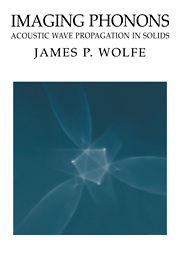Book contents
- Frontmatter
- Contents
- Preface
- Prologue – Anisotropic heat flow in crystals
- 1 Ballistic heat pulses and phonon imaging – A first look
- 2 Phonon focusing
- 3 Generation and detection of phonons – Experimental aspects
- 4 Focusing in cubic crystals
- 5 Acoustic symmetry and piezoelectricity
- 6 Lattice dynamics
- 7 Imaging of dispersive phonons
- 8 Phonon dynamics
- 9 Bulk scattering of phonons – Experiments
- 10 Quasidiffusion and the phonon source
- 11 Phonon scattering at interfaces
- 12 Refraction and reflection at solid/solid interfaces – Experiment
- 13 Imaging ultrasound in solids
- 14 Imaging surface acoustic waves
- 15 Interactions of ballistic phonons with electrons
- Appendix I Algebraic solution to the wave equation
- Appendix II Abbreviated tensor notation and group velocity
- Appendix III Survey of phonon focusing in cubic crystals
- Index
11 - Phonon scattering at interfaces
Published online by Cambridge University Press: 24 March 2010
- Frontmatter
- Contents
- Preface
- Prologue – Anisotropic heat flow in crystals
- 1 Ballistic heat pulses and phonon imaging – A first look
- 2 Phonon focusing
- 3 Generation and detection of phonons – Experimental aspects
- 4 Focusing in cubic crystals
- 5 Acoustic symmetry and piezoelectricity
- 6 Lattice dynamics
- 7 Imaging of dispersive phonons
- 8 Phonon dynamics
- 9 Bulk scattering of phonons – Experiments
- 10 Quasidiffusion and the phonon source
- 11 Phonon scattering at interfaces
- 12 Refraction and reflection at solid/solid interfaces – Experiment
- 13 Imaging ultrasound in solids
- 14 Imaging surface acoustic waves
- 15 Interactions of ballistic phonons with electrons
- Appendix I Algebraic solution to the wave equation
- Appendix II Abbreviated tensor notation and group velocity
- Appendix III Survey of phonon focusing in cubic crystals
- Index
Summary
The Kapitza problem
The transport of thermal energy across solid/solid and solid/liquid interfaces has occupied and perplexed many researchers since Kapitza's famous experiments in 1941. He discovered the existence of a sharp temperature gradient at the surface of a heated solid that was immersed in liquid He. This surprisingly steep temperature drop was observed to occur within a few tens of micrometers of the surface, which was the spatial resolution of the experiment.
It was first suggested that the source of this discontinuity was a thick boundary layer of He that limited the thermal conductivity. However, such mechanisms proved unnecessary, as Khalatnakov realized that the measured thermal boundary resistance between the solid and liquid was actually much smaller than predicted from a simple acoustic-mismatch theory. One defines the thermal boundary resistance as, where ΔT is the temperature drop across the boundary for a given power flow.
Khalatnakov reasoned that the solid and the He have quite disparate acoustic impedances (Z = ρν, with ρ the density and ν the sound velocity), which implies a small phonon transmission coefficient across the interface. Modeling the solid and liquid as classical acoustic media, he predicted that the average transmission coefficient of an acoustic wave should be approximately 1%, whereas the measured thermal boundary resistances corresponded to a transmission coefficient of approximately 50%. This disparity between theory and experiment is known as the “Kapitza anomaly.” Fifty years after Kapitza's measurements, this anomaly is not completely resolved.
- Type
- Chapter
- Information
- Imaging PhononsAcoustic Wave Propagation in Solids, pp. 275 - 298Publisher: Cambridge University PressPrint publication year: 1998

